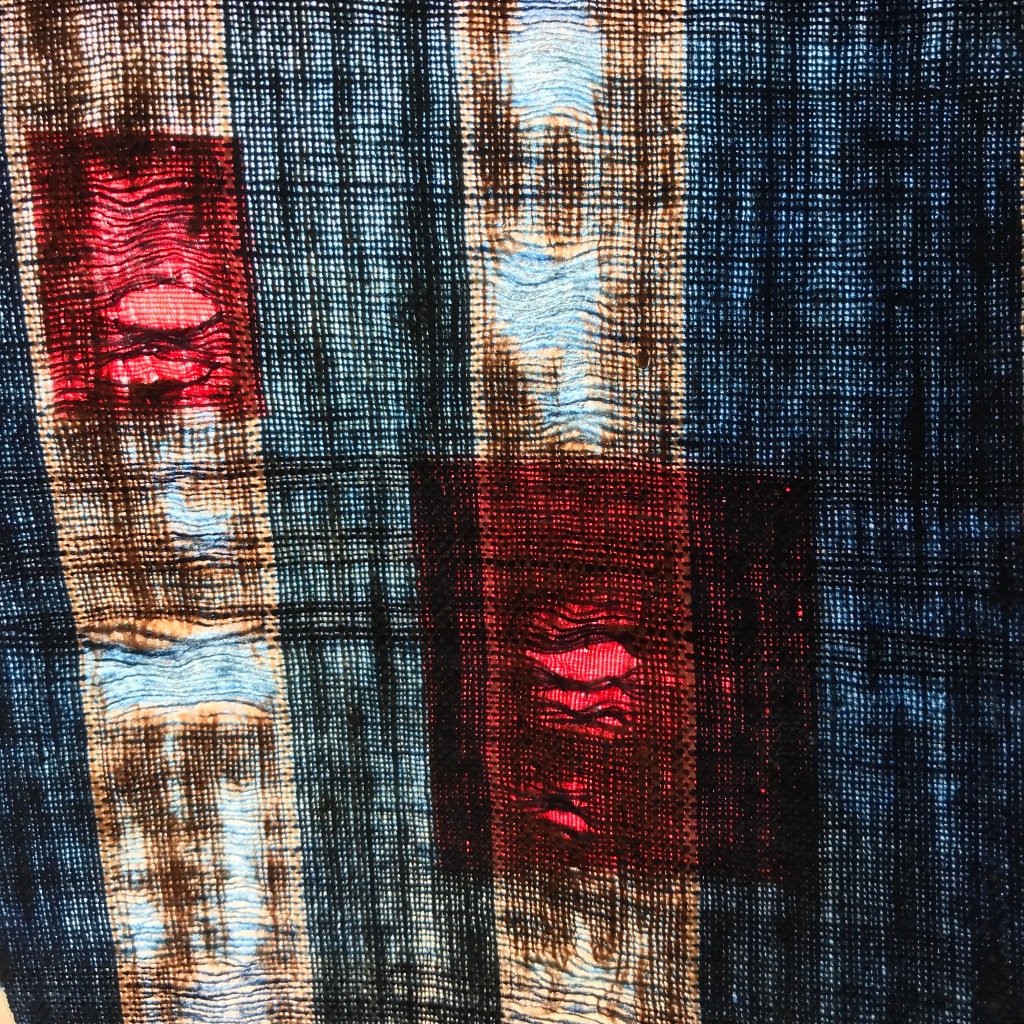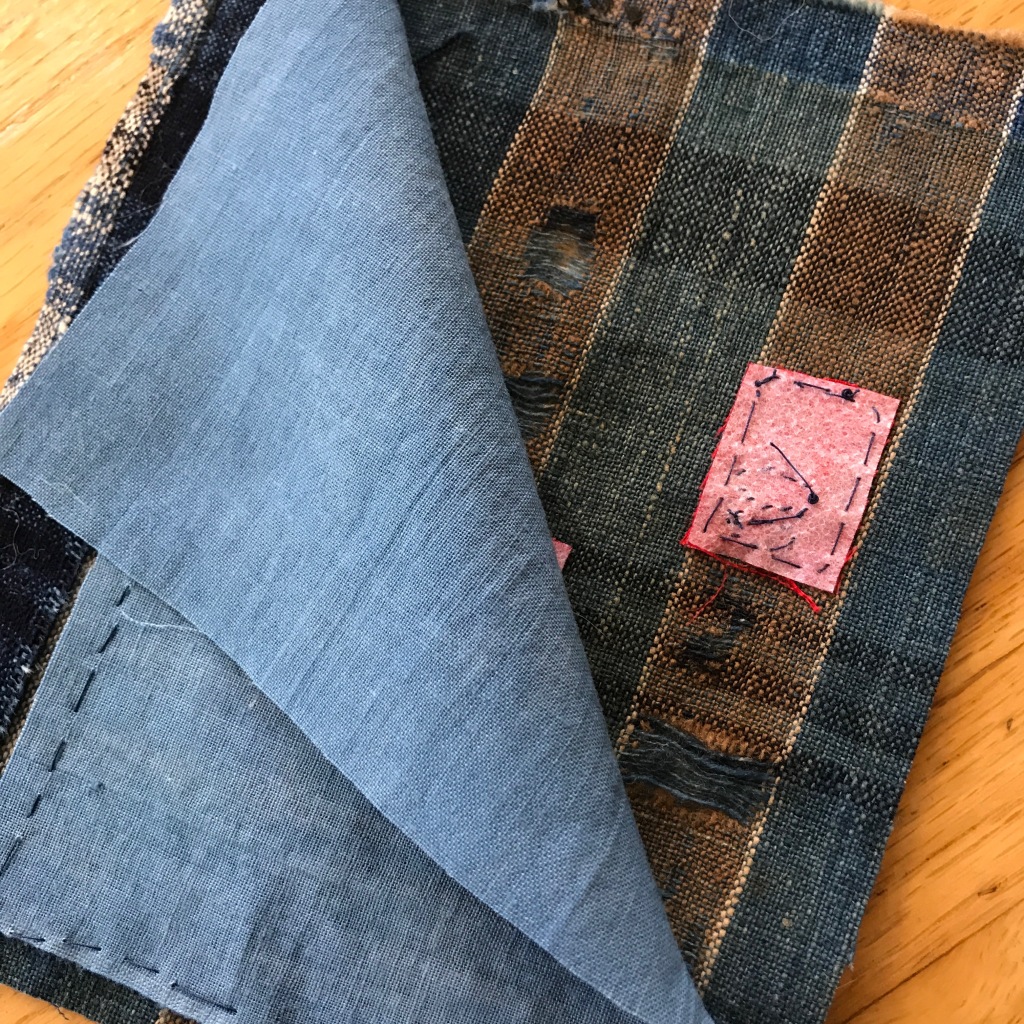I started working on this piece of cloth in order to add it to a larger piece I am stitching. The whole cloth itself is made from reclaimed, recovered, and salvaged bits of cloth-some redyed, restitched. This one in particular is from a couple of those categories.
Time stitching is time to think and reflect…
When the fabric of our lives seems to errode and threads are laid bare, those of us who have the means, the desire, or the ability to strengthen the surrounding cloth/life can help hold it together. Stitching around the red silk, the cloth/wound was revealed, memorializing it’s existence, strengthened and preserved. The still fragile and ever eroding stripes/lives are grounded by solid yet invisible (on the front side) tiny stitches. The back side shows the structure and the pieces and stitches added in an effort, though impossible, to make the cloth/person whole again. Scars/tears will remain, lives lost and forever altered.
This cloth is a small tribute to those who lost their lives this past week in Long Beach CA. In quiet moments of handwork, these thoughts rise up.

I chose this piece as it showed the story of the cloth from several perspectives. It had been reused previously (most likely as a cushion or futon cover) and taken apart. With several holes in it perhaps, the intention being to patch and reuse again.

As I handled the piece to think about how to apply it to the larger piece it became apparent that it needed some stabilization first. Using that same red silk I’ve shown you recently, I decided to highlight a couple of the duty worn areas. As I turned it over in my hand, I realized that the wear on this piece was really only in the warp areas of the brown dyed sections. This being a mainly indigo piece, it was warped in a couple of shades of indigo and what looks to be kakishibu (persimmon) dyes. The weft is indigo in two shades. What you notice is that only the kakishibu dyed sections are deteriorating- telling me that this dye was more damaging to the fibers over time. Was it treated with an iron mordant and not well rinsed? Not sure. But it’s very clear that only those sections broke down over time telling me it is dye related and not wear related.

I applied the lightest weight stabilizer to the back of the very fine red silk which I used. First stitching invisibly (front side) to stabilize the section and then further stitching the open areas revealing a bit of the red silk. Holding it up to the light, reveals its strengths and weaknesses.
I further decided that it needed more stability and added a larger piece of thin indigo dyed cotton to the backside. Copying methods I have seen on some of the vintage boro I have, I stitched the edges and again along either sides of the deteriorating stripes. It’s now ready to be part of the larger piece.

Above is just the process I used to stabilize the worn scrap. As I said in the video (last post), using the red silk to highlight patched areas reminds me of the Japanese ceramic technique generally called kintsugi. Looking up the translation of that word it contains the kanji for tsugi which means “inherit, succeed, continue, patch, graft”. So carrying this further, tsugimono would be something that is in need of patching.
Yes, the patchwork that is our life, our clothstory. Stabilized, but not made whole.


Your thoughts on the metaphor of life and fabric (and so much of what you write) speak to my soul where they find a kindred spirit home. I feel blessed and enriched. Thank you.
LikeLiked by 1 person
you are always welcome in this spirit home nancy…
LikeLike
such a beautiful repair & thoughts
LikeLiked by 1 person
stitching can be a meditation can’t it Mo?
LikeLike
in the hands of a good stitcher yes!
LikeLiked by 1 person
So curious what the dye or mordant used that caused the fiber to weaken. Maybe iron, acids can weaken cotton (forgot what fiber your plaid is ). Though read about ancient fermenting tannin iron dyes in Finland or Sweden that actually strengthened fiber (may have been wool). Maybe persimmon dye? Had just recieved a newsletter from Spinoff and it had article on mending and someone, Tomholland.com https://spinoffmagazine.com/roving-reporter-mending-year-3-tips-darning-well/ I have trouble tossing old holy clothing and am using some to patch other and layers to have “blankets” . Also this person mends nicely- https://www.afieldguidetoneedlework.com/blog/madder-red Have old jeans that might use to make bags, containers… some have composted around a young tree that ivy was strangling.
Have an old Kimono and some fabric, maybe you could tell some about them if sent a pic? Have a good week , offf to water plants and eat breakfast. Lynn
LikeLike